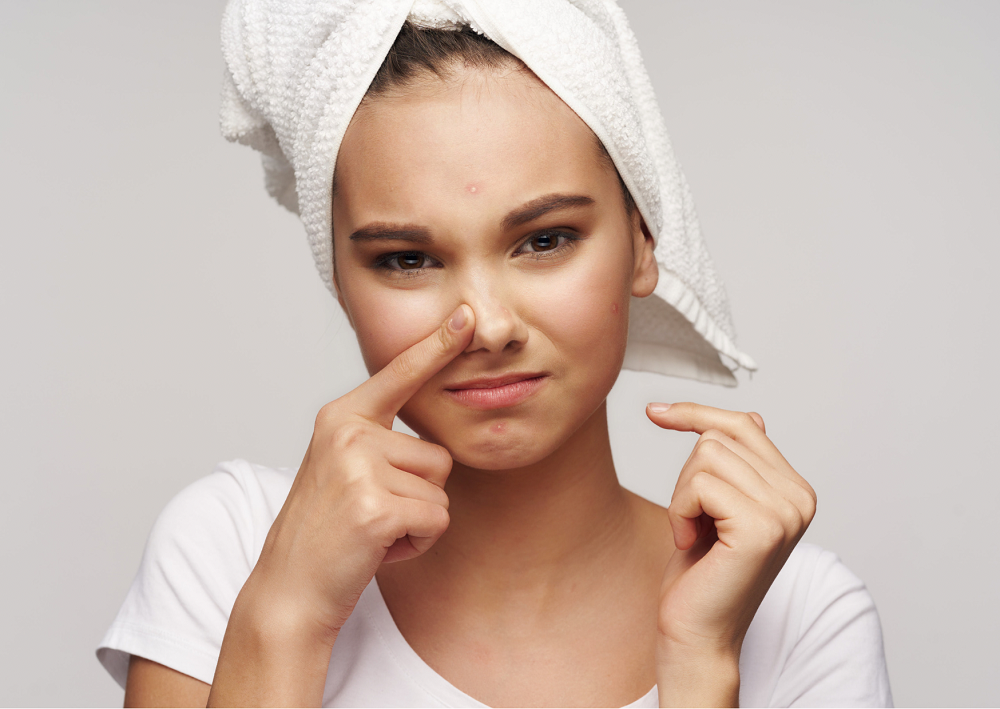
Acne is the technical term for what most people refer to as “problem skin, pimples, blemishes, break outs or zits”. It is a common skin condition that affects both young and old and occurs when a hair follicle and its associated oil (sebaceous) gland becomes blocked and inflamed. Acne is characterized by any combination of blackheads, whiteheads, papules, pustules, nodules, or cysts. Typically they occur on the face, neck, back, and shoulders – as these locations present a higher concentration of sebaceous glands. If left untreated or treated in the wrong way, acne can also lead to further skin complications, such as scarring, redness, hyperpigmentation and general inflammation.
What Causes Acne?
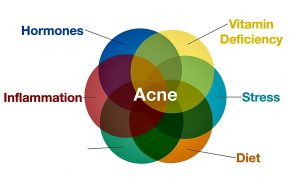
Excess sebum (oil) production can be caused by several factors, the most common culprit being hormonal imbalance. This can be due to puberty, pregnancy, genetics or even stress. Other acne-contributing factors may include lifestyle, diet or incompatible skincare products.
The skin contains many tiny hair follicles and pores. Each pore contains a hair and a multi-lobed gland called a sebaceous gland. Sebaceous glands produce an oily substance called sebum, which normally travels up the pore to lubricate the hair and skin.
Acne develops when a pore becomes clogged with excess sebum and dead skin cells. Bacteria in the deeper part of the hair follicle and beneath the sebum blockage release chemicals which act upon the sebum and break it down to release other chemicals. These chemicals make the skin around the hair follicle red and inflamed, resulting in a pimple. In bad cases, pus may develop within the pimple. Large, painful swellings called nodules and cysts may develop and result in scarring after the condition has eventually settled.

Understanding The Different Types Of Acne
There are several different types of acne lesions and each individual may have predominantly one form of acne or a combination of lesions present at one time. Identifying the acne type is the first step towards effective treatment.

Acne falls into two main categories: non-inflammatory and inflammatory. Blackheads and whiteheads are the two types of non-inflammatory acne. These blemishes form when the pores become clogged with excess oil and dead skin cells. But they can become inflamed if the pore becomes infected with bacteria. This can lead to inflammatory acne, including papules, pustules, nodules and cysts.
Types Of Non-inflammatory Acne
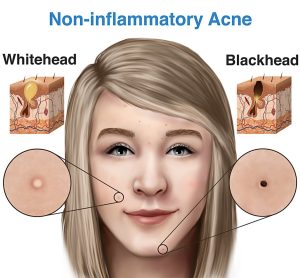
Whiteheads
Whiteheads are small white bumps that appear on the surface of the skin. They are formed when a pore becomes blocked with oil, bacteria, and dead skin cells and the pore remains closed. They are called “closed comedones” because skin cells completely block the pore’s opening.
Blackheads
Blackheads are caused by a build-up of sebum, dead skin cells and other impurities which clog the pore. When this build-up is exposed to air, it gets oxidised which results in the characteristic shade of black/ brown that give blackheads their name. They are also called “open comedones” because skin cells partially block the opening of the pore.
Types Of Inflammatory Acne
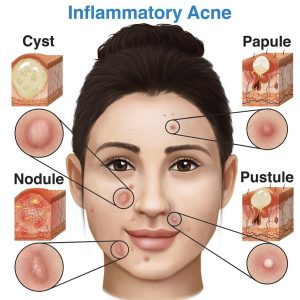
Papules
Papules are red lesions that contain no white or yellow center. They are the first lesion to develop after the wall of the clogged pore breaks.
Pustules
Pustules develop as a papule matures. They are red lesions with a white or yellow center, which is the result of the accumulation of white blood cells, called pus, inside the pore. Pustules are what many people refer to as “pimples” and “zits.”
Nodules
Nodules are by far the most common severe acne lesion. They are large fibrous lesions that contains no white or yellow center, and are red, swollen, and usually painful. Nodules result when a clogged pore completely breaks down deep in the skin. This results in a severe inflammatory response which frequently causes severe tissue damage that often leads to scarring.
Cysts
This is the most severe form of acne . Cysts are red, swollen, develop deep in the skin and are often painful. However, unlike a nodule, cysts are not fibrous. Instead, they are filled with liquid or pus.
Eventually, the immune system heals an acne lesion by reducing inflammation and attempting to repair damage to the skin that the acne lesion may have caused. However, if the immune system creates excessive inflammation in an acne lesion, or if it does not heal the acne lesion quickly, scarring may occur.

Acne can be classified as mild, moderate, or severe depending on the type and number of lesions, and whether inflammation is present.
The severity of acne is often categorised as:
- mild – mostly whiteheads (closed comedones) and blackheads (open comedones) with a few papules and pustules.
- moderate – more widespread whiteheads and blackheads and many papules and pustules
- severe – large numbers of papules and pustules along with nodules and cysts. Severe acne tends to have lots of inflammatory acne and can have acne scarring as well.
How Is Acne Treated?
Not all acne is the same and treatments are tailored to each individual according to severity and depends on many considerations, including:
- The type of acne
- Where the acne appears on the skin
- Current and previous treatments and response to these treatments
- When the breakouts started
- Whether the acne has left dark spots or scars
The aim of treatment is to:
- Reduce the number of comedones (blackheads and whiteheads)
- Reduce the inflammation (pimples and red bumps)
- Reduce the likelihood of permanent pigment changes (skin discolouration)
- Prevent scarring
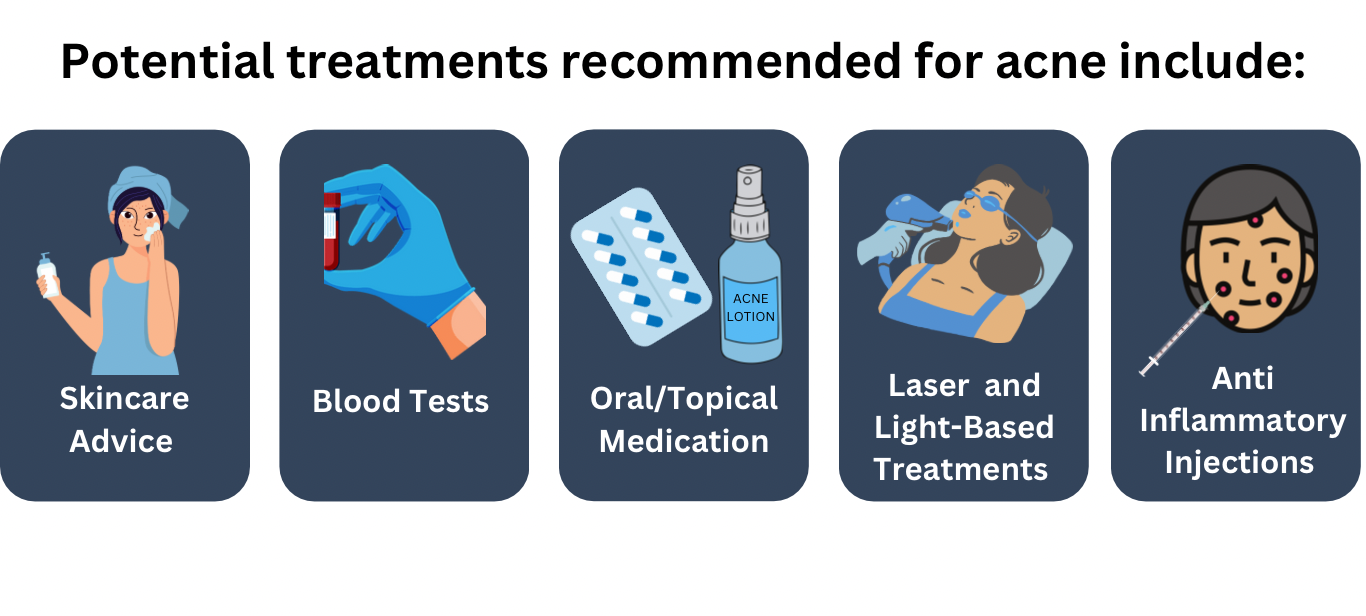
At Alaxis Medical, we focus on fighting the root cause of breakouts, by diagnosing the type of acne you may have, combining in-clinic treatments with tailored home skincare recommendations to accelerate visible results and help you regain control of your skin.
The best place to start is with a personalised and tailored diagnosis. Start today by securing a consultation.
Frequently Asked Questions
What acne treatment is right for me?
The best acne treatment for you can be as unique as your skin. For some, it could be as simple as changing their skincare routine with a new cleanser and moisturiser. For others, the treatment may entail more severe changes such as topical medications, oral medications, and skin treatments.
If you are unsure what acne treatment is right for you, you can speak with our medical team for impartial help and advice. The top priority is to identify the underlying causes of your acne, in order to determine what treatment you should have. If non-prescription treatments have not worked for you, now is the time to speak to us.
Does acne always scar?
Acne does not always scar. The likelihood of scarring occurring depends on your skin type, acne severity, genetics and your propensity for scarring. Atrophic (indented) acne scars occur when damage to the pore causes a loss of tissue. Hypertrophic (raised) acne scars, on the other hand, involve an overgrowth of tissue. It is therefore essential to avoid squeezing acne, and to consult a medical professional as soon as you experience severe or cystic acne.
How can I help myself?
If you have acne at the moment here are a few tips that may help:
- Use non-comedogenic products or oil-free products including moisturiser and sunscreen
- Use a gentle cleanser to wash your face
- Do not pick or ‘pop’ your acne as it will leave scars
- Do not scrub your face if it feels oily as it can worsen acne-prone sensitive skin
- Seek professional help to treat your acne early
Will I need to continue having treatment?
Long-term acne requires continual treatment to manage flare-ups. Many patients try different treatments to find the most optimal application that works for them. Most patients undergo a strict acne treatment plan to get started and then taper off with alternative treatments. are MOST likely NOT in the order of what you need, is highly irrelevant, and, not in your interests of attaining accelerated results.
Before and After Photos
In compliance with MOH guidelines in Singapore, we are not allowed to post before-and-after images on our website and social media platforms. However, we are more than willing to share such images for your perusal during your in-clinic consultation with us.


